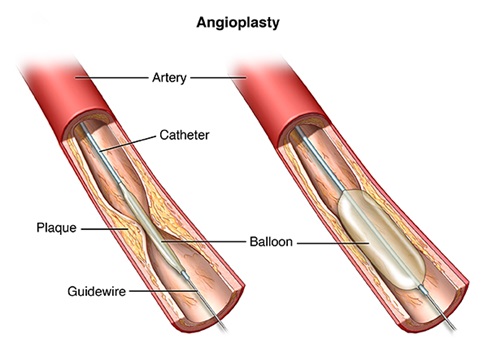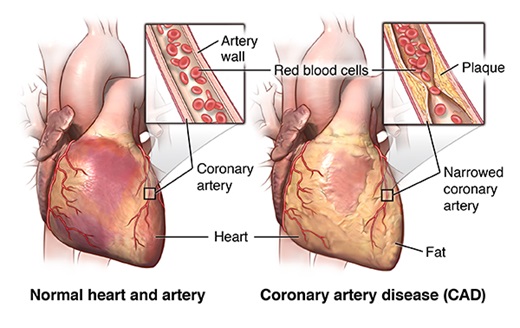What is Angioplasty?

Coronary stents have become a standard component of angioplasty procedures, employed to uphold the integrity of newly opened arteries. These stents, typically constructed as tiny, expandable metal mesh coils, serve the crucial function of preventing the re-narrowing or closure of arteries post-procedure.
Following stent placement, a natural process called endothelialization occurs, wherein tissue gradually coats the stent, akin to the formation of a layer of skin. This process generally takes place over a period of 3 to 12 months, though the duration may vary based on whether the stent is medicated or not.
Medication-coated stents, known as drug-eluting stents, are designed to release drugs into the bloodstream that inhibit the excessive growth of tissue within the stent. This mechanism helps to forestall restenosis, the re-narrowing of the artery, by mitigating the formation of scar tissue. However, recipients of drug-eluting stents often require long-term administration of antiplatelet medications to prevent blood clot formation within the stent.
In contrast, bare metal stents lack medication coatings and may pose a slightly higher risk of restenosis. However, they are advantageous for individuals at elevated risk of bleeding, as they do not necessitate prolonged antiplatelet therapy.
Despite their benefits, stents can occasionally become obstructed due to the accumulation of scar tissue within the stent. In such cases, a repeat procedure may be warranted, involving either balloon angioplasty or the insertion of a second stent. Alternatively, in rare instances where scar tissue formation is particularly problematic, radiation therapy via a catheter near the affected tissue may be utilized to inhibit its growth and maintain vessel patency, a procedure known as brachytherapy.
Patients who undergo stent placement should remain vigilant for symptoms such as chest pain, as these may indicate potential issues with the stent. Open communication with healthcare providers is crucial to address any concerns and ensure appropriate follow-up care.
Why might I need angioplasty?
Angioplasty is a procedure aimed at reinstating blood flow in coronary arteries by widening narrowed segments. It's selectively performed based on the location and accessibility of the affected artery. However, not all cases of coronary artery disease (CAD) are amenable to angioplasty. The decision regarding CAD treatment approach is individualized, with healthcare providers considering various factors to determine the most suitable course of action for each patient's condition.
What are the risk of Angioplasty?
Angioplasty, stenting, atherectomy, and related procedures entail certain risks that patients should be aware of before undergoing treatment. These risks encompass potential bleeding at the catheter insertion site, formation of blood clots or vessel damage, risk of infection, abnormal heart rhythms, heart attack, stroke, chest discomfort, and the rare but serious possibility of coronary artery rupture or complete closure necessitating open-heart surgery. Additionally, allergic reactions to contrast dye and kidney damage from its use are potential concerns.

Patients should actively inquire about the radiation exposure involved in these procedures and its associated risks, maintaining a record of their exposure to inform their healthcare team. Some patients may experience discomfort or pain from having to lie still during the procedure, while others may face additional risks depending on their specific health condition. Discussing any concerns with healthcare providers before the procedure is crucial for addressing individual needs and ensuring a comprehensive understanding of potential risks and benefits.
Your healthcare team will guide you through the procedure, encouraging you to ask any questions you may have. Before proceeding, carefully review and inquire about any unclear aspects of the consent form. Inform your healthcare provider about any past reactions to contrast dye or allergies to iodine.
Additionally, disclose any sensitivities or allergies to medications, latex, tape, or anesthesia. Adhere to any pre-surgery instructions provided, especially regarding fasting. If pregnancy is a possibility, notify your healthcare team due to radiation exposure risks.
Mention any body piercings on your chest or abdomen and provide a comprehensive list of all medications, including prescriptions, over-the-counter drugs, vitamins, herbs, and supplements. It's crucial to disclose any history of bleeding disorders or current use of blood-thinning medications like anticoagulants or aspirin.
Blood tests may be conducted to evaluate clotting ability, particularly if you have a history of bleeding disorders or are taking blood-thinning medications. Inform your healthcare team about any pacemakers or other implanted devices.
To aid relaxation, you may receive a sedative before the procedure. Depending on your health status, your healthcare provider may provide additional preparatory instructions.
Angioplasty is a common procedure used to restore blood flow to narrowed or blocked coronary arteries, typically performed as part of a hospital stay. The process involves several steps tailored to individual patient needs and healthcare provider preferences.
-
Preparation: Patients are instructed to remove any jewelry or objects that might interfere with the procedure and change into a gown. They may also be asked to empty their bladder before the procedure to ensure comfort during the process.
-
IV Line Placement: An intravenous (IV) line is inserted into the hand or arm to administer medications and fluids as needed during the procedure.
-
Patient Positioning and Monitoring: Patients are positioned on their backs on the procedure table and connected to an electrocardiogram (ECG) monitor to track heart activity and vital signs throughout the procedure.
-
Local Anesthesia: Local anesthesia is administered at the site of catheter insertion, usually in the groin, arm, or neck, to minimize discomfort during the procedure.
-
Sheath Insertion: A sheath or introducer is placed into the blood vessel, typically at the groin, through which the catheter is threaded into the bloodstream and advanced to the heart.
-
Catheter Advancement and Imaging: The catheter is guided through the sheath into the blood vessels and advanced into the coronary arteries using fluoroscopy (live X-ray) to visualize its movement.
-
Contrast Dye Injection: Contrast dye is injected through the catheter into the coronary arteries to visualize any narrowed areas, which may cause temporary sensations like flushing, metallic taste, or headache.
-
Balloon Inflation and Stent Placement: Once the narrowed artery is identified, a balloon is inflated to open the artery. In some cases, a stent may be inserted to maintain artery patency, either before or after balloon inflation.
-
Post-procedure Assessment and Closure: Measurements, images, or angiograms are taken to assess artery patency. After confirming sufficient artery opening, the catheter is removed, and the insertion site is closed using various methods such as closure devices, stitches, or manual pressure.
-
Recovery and Monitoring: Patients are assisted in transitioning to a stretcher and taken to the recovery area. Depending on the insertion site, precautions may be taken to prevent bleeding or discomfort, such as leg elevation or arm immobilization.
Overall, angioplasty is a well-established procedure with a structured process aimed at restoring blood flow to the heart and improving patient outcomes. Close monitoring and follow-up care are essential components of the recovery process to ensure optimal recovery and long-term health.
What happens after surgery?
After angioplasty, patients are typically observed in the recovery room or returned to their hospital room. If the catheter was inserted in the groin or leg, they will remain flat in bed for several hours, with vital signs and circulation monitored closely. Bed rest duration varies based on individual condition, ranging from 4 to 6 hours, or shorter if a closure device was used. Patients may experience frequent urination due to contrast dye effects and are encouraged to drink fluids. Pain medication may be provided, and patients can resume their usual diet unless advised otherwise. Discharge instructions and recovery guidelines are provided before leaving the hospital.


Nice
You must be logged in to post a comment.